Trauma: Pulmonary Trauma
Pulmonary Injury
AAST Lung Injury Scale
- *See AAST
- Injury Scale is Under Copyright
Pulmonary Contusion
- Edema & Inflammation Causing Impaired Gas Exchange
- Most Common in High-Energy Blunt Trauma
- Presents 24-48 Hours Post-Trauma
- CXR Changes Evolve Slowly & Lag Behind Worsening Respiratory Status
- Dx: CXR/CT
- Tx: Diuretics & Fluid Restriction
Pulmonary Parenchymal Injury
- Large Laceration
- Tx: Wedge Resection
- Deep Penetrating Wound with Air Leak/Bleeding
- Tx: Tractotomy & Deep Vessel Ligation
- Linear Stapler Through Tract to Access Bleeding Vessel
- Tx: Tractotomy & Deep Vessel Ligation
- Devascularized/Destroyed Lobe
- Tx: Lobectomy
- Last Resort: Pneumonectomy
- Complications: Severe Respiratory Failure and Right-Sided Heart Failure
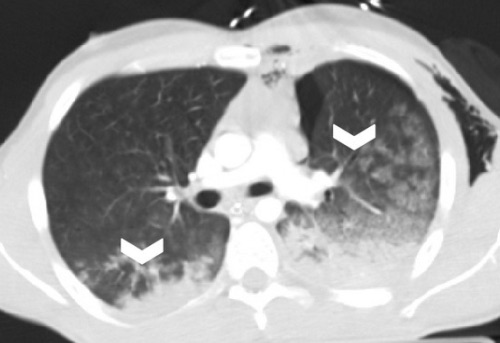
Pulmonary Contusion 1
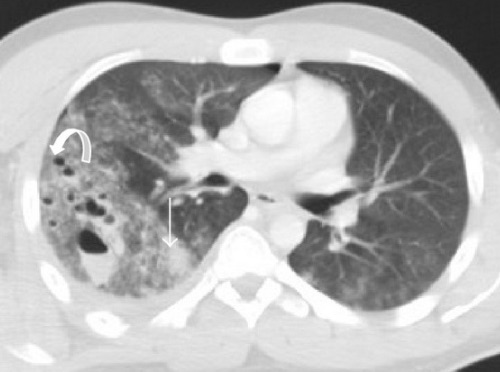
Pulmonary Laceration; Curved Arrow – Pneumatocele, Straight Arrow – Hematocele 1
Pneumothorax (PTX)
Nontraumatic
CXR Findings
- Sensitivity:
- Upright: 92%
- Supine: 50%
- *20% of “Occult” PTX in Trauma was Actually “Missed”
- General Radiographic Findings:
- Pleural Line Separating Lung from Chest Wall
- Loss of Normal Lung Markings to the Peripheral Chest Wall
- Radiographic Signs in a Supine CXR:
- Deep Sulcus Sign: Abnormally Deepened Ipsilateral Costophrenic Angle
- Seen on Supine CXR Because Air Collects Anteriorly/Basally
- The Most Commonly “Missed” Sign
- COPD Can Cause a False Deep Sulcus Sign Due to Hyperinflation
- Relative Lucency of Ipsilateral Hemithorax
- Increased Sharpness of Cardiac Border, Mediastinal Margin or Diaphragm
- Depression of the Ipsilateral Hemidiaphragm
- Double Diaphragm Sign: Visualization of the Anterior Costophrenic Sulcus (Due to Air) and the Diaphragmatic Dome (Due to Lung Border)
- Pericardial Fat Tag Sign: Nodular Contour of the Cardiac Border
- Due to Change in Shape of the Pericardial Fat that is No Longer Compressed by the Lung
- Deep Sulcus Sign: Abnormally Deepened Ipsilateral Costophrenic Angle
Simple Pneumothorax
- After Penetrating Injury 80% Have Concomitant HTX
- Dx: CXR/CT
- PEEP from Mechanical Ventilation Can Cause Persistent Air Leaks
- Tx:
- ASx & Small (< 3 cm): Repeat CXR in 6 Hours
- Supplemental Oxygen May Enhance Reabsorption – Reduces Partial Pressure of Nitrogen for a Diffusion Gradient
- Sx or > 3 cm: Chest Tube
- *See Trauma: Tube Thoracostomy(Chest Tube)
- Persistent Air Leak After 72 Hours: VATS
- ASx & Small (< 3 cm): Repeat CXR in 6 Hours
Tension Pneumothorax
- Sx: JVD, Hypotension & Tracheal Deviation
- Underlying Pathophysiology: Decreased Venous Return & Circulatory Collapse
- Dx: Clinical
- Tx: Needle Decompression Followed by Chest Tube
- Large Bore Needle (14 Gauge) Through Midaxillary Line at 4th/5th Intercostal Space
- *Historically Placed at the 2nd/3rd Intercostal Space – Higher Risk of Failing to Actually Penetrate the Pleural Cavity
Open Pneumothorax (Sucking Chest Wound)
- Opens on Inspiration, Closes on Expiration
- Can Cause Tension PTX
- Tx: Chest Tube (Distant Site) & Occlusive Dressing, Taped on 3 Sides
- Allows Air to Escape but Not Enter
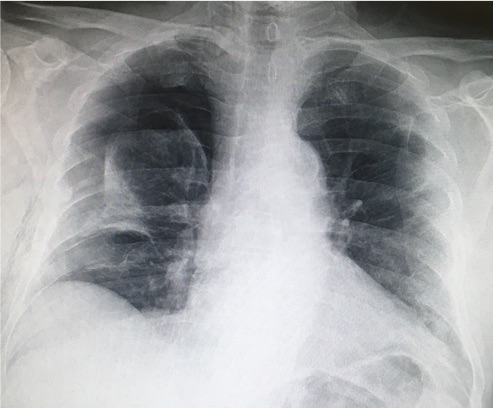
PTX
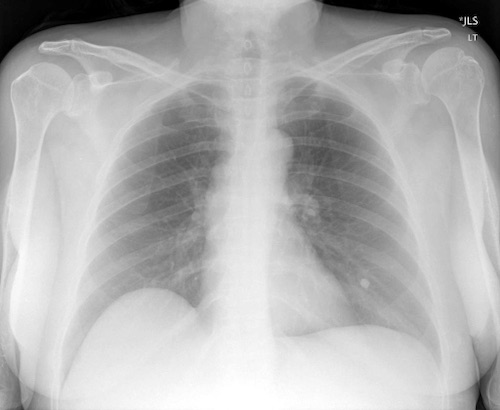
Deep Sulcus Sign (Right) on Supine CXR 2
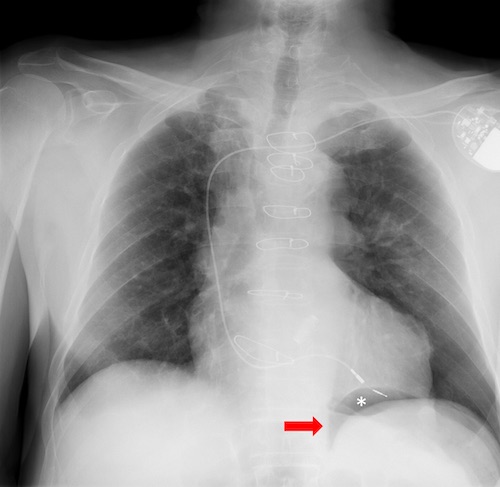
Double Diaphragm Sign (Astrisk) on Supine CXR 3
Hemothorax (HTX)
Treatment
- Initial Tx: Chest Tube
- Thoracotomy Indications:
- Initial Loss: > 1,500 cc
- Continual Loss: > 200 cc/hr for 4 Hours
- Some Say 250 cc/hr for 3 Hours
- If Concern for Major Vessel Injury: Preform Appropriate Arterial Exposure
- Second Chest Tube May Be Required if Not Draining (Not After 1-2 Days)
Retained HTX
- Chest Tube Fails to Completely Evacuate HTX After 2-3 Days
- Occurs in 5% of Cases
- Risk Factors: Prolonged Ventilation, PNA or Break in Pleura (Chest Tube)
- High Risk of Fibrothorax and Empyema
- Dx: CT (Need Before OR)
- Tx: VATS
- Not Second Chest Tube
- Timing: Preform Within 7 Days (Before Loculations Develop)
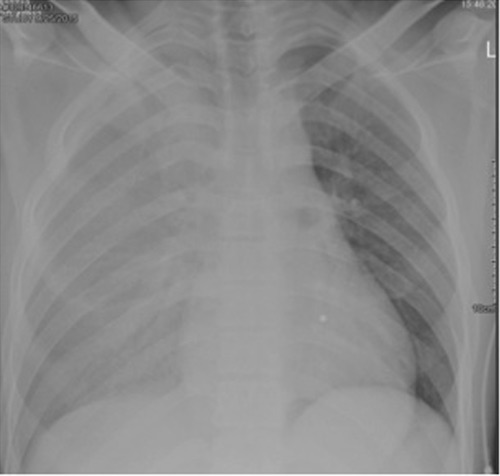
HTX 4
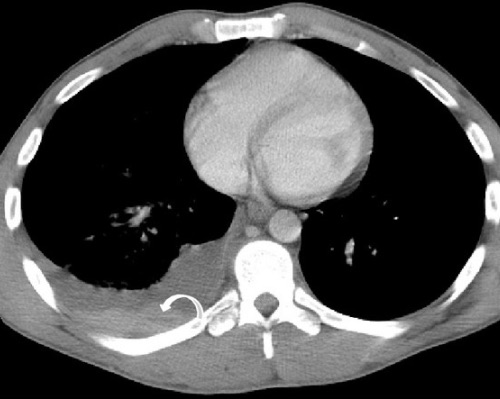
Retained HTX with Hematocrit Sign 1
Tracheobronchial Injury
Basics
- If SpO2 Drops After Chest Tube – Clamp Chest Tube
- Most Common on Right & with Blunt Trauma
- 90% within 1 cm of Carina
Diagnosis
- Presentation: Large Continuous Air Leak, Hemoptysis, Pneumomediastinum & PTX
- Dx: Bronchoscopy
Airway Management
- Maintaining Airway: Consider Conservative
- Suspected Laryngotracheal Injury: Tracheostomy
- Endotracheal Intubation Can Worsen Damage
- Distal Injury: Mainstem Single-Lumen Endotracheal Tube to the Unaffected Side
Surgical Repair
- Indications:
- Respiratory Compromise
- Unable to Insufflate Lung
- Injury > 1/3 Diameter of Trachea
- Persistent > 2 Weeks
- Approach:
- Extrathoracic Injury: Transverse Cervical Incision
- Most Thoracic Injuries: Right Posterolateral Thoracotomy
- Distal Left Mainstem Injury (> 3 cm from Carina): Left Posterolateral Thoracotomy
- Surgery: Primary Repair or End-to-End Anastomosis
- If Under Tension: Can Flex Neck & Suture Chin to Chest to Maintain Postoperatively
- Consider Reinforcement with Vascularized Pedicle or Intercostal or Strap Muscles
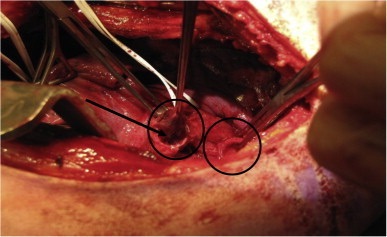
Left Main Bronchus Transection 5

Bronchial Transection 6
References
- Palas J, Matos AP, Mascarenhas V, Herédia V, Ramalho M. Multidetector computer tomography: evaluation of blunt chest trauma in adults. Radiol Res Pract. 2014;2014:864369. (License: CC BY-4.0)
- Kohli MD, Rosenman M. Indiana University.2013. (License: CC BY-NC-ND-4.0)
- Moreno SA, et al. Thoracic Trauma: A Comprehensive Review of Radiological Findings. ECR 2015. Poster C-2031. DOI: 10.1594/ecr2015/C-2031. (License: Open Liscence – Not Specified)
- Mishra B, Joshi MK, Kumar S, Kumar A, Gupta A, Rattan A, Sagar S, Singhal M, Misra MC. Innocuous cardiac gunshot that proved fatal: A bitter lesson learned. Chin J Traumatol. 2017 Apr;20(2):122-124. (License: CC BY-NC-ND-4.0)
- Groenendijk MR, Hartemink KJ, Dickhoff C, Geeraedts LM Jr, Terra M, Thoral P, Hashemi SM. Pneumomediastinum and (bilateral) pneumothorax after high energy trauma: Indications for emergency bronchoscopy. Respir Med Case Rep. 2014 Jul 11;13:9-11.(License: CC BY-NC-ND-3.0)
- Oikonomou A, Prassopoulos P. CT imaging of blunt chest trauma. Insights Imaging. 2011 Jun;2(3):281-295. (License: CC BY-4.0)